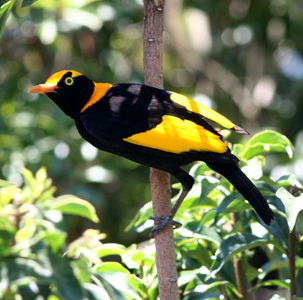Regent Bowerbird (Sericulus chrysocephalus) - Wiki Regent Bowerbird
From Wikipedia, the free encyclopedia
[Photo] Male Regent bowerbird at Lamington National Park.
The Regent Bowerbird, Sericulus chrysocephalus is a medium-sized, up to 25cm long, sexually dimorphic bowerbird. The male bird is black with a golden orange-yellow crown, mantle and black-tipped wing feathers. It has yellow bill, black feet and yellow iris. The female is a brown bird with whitish or fawn markings, grey bill, black feet and crown.
All male bowerbirds build bowers, which can be simple ground clearings or elaborate structures, to attract female mates. Regent bowerbirds in particular are known to mix a muddy grayish blue or pea green "saliva paint" in their mouths which they use to decorate their bowers. Regents will sometimes use wads of greenish leaves as "paintbrushes" to help spread the substance, representing one of the few known instances of tools used by birds.[1]
An Australian endemic, the Regent Bowerbird is distributed to rainforests and margins of eastern Australia, from central Queensland to New South Wales. The diet consists mainly of fruits, berries and insects. The male builds an avenue-type bower consisting of two walls of sticks, decorated with shells, seeds, leaves and berries.
The name commemorates the Prince Regent of the United Kingdom.
A common species throughout its range, the Regent Bowerbird is evaluated as Least Concern on the IUCN Red List of Threatened Species.
http://en.wikipedia.org/wiki/Regent_Bowerbird
| The text in this page is based on the copyrighted Wikipedia article shown in above URL. It is used under the GNU Free Documentation License. You may redistribute it, verbatim or modified, providing that you comply with the terms of the GFDL. |
